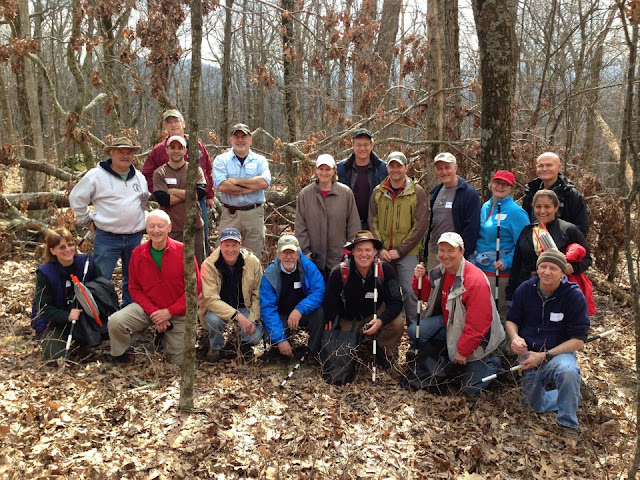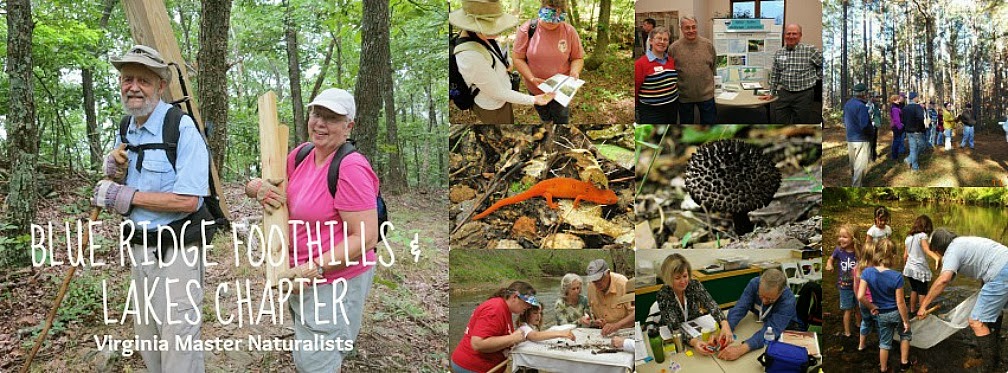On snowy Sunday, March 24th about a dozen BRFAL
Chapter members along with eight others met in Roanoke to
receive our eMammal camera deployment training.
Just what is eMammal Camera Deployment training and why would a passel
of otherwise intelligent people risk life and limb to attend this training?
 |
| One BRFAL dude training the week prior, NOT IN THE SNOW (Rick in brown hat front center) "Here is the picture of the first volunteer cohort of 2013 from the training at the Wintergreen Nature Foundation." Photo courtesy of eMammal. |
Well eMammal is a citizen science project sponsored by the
Smithsonian Institution Museum of Natural Sciences. It concerns one of the fundamental questions
of ecology concerning the distributions of organisms (in the case mammals)
throughout our environment. Technology
is now making this somewhat easy with the advent of field cameras that can be
placed in the field and be set to automatically get photographic evidence of
the movement of various species day and night.
In order to help the scientists from the Smithsonian with
this task a 4+ hour training session was held.
We learned how to set up and use our GPS’s so that we can both find and record
the actual locations for placing the field cameras.
We then learned how to use and place the cameras in the
field. Each camera uses 12 NiMH
rechargeable batteries and an SD memory card.
Once the camera is secured to a tree at the correct height with a
“Python cable lock”, it then must be calibrated with a “walk test” to determine
the maximum distance the camera will record movement and then the “pole test”
in which a calibrated pole is moved in a zigzag pattern away from the camera
while being photographed. This allows
the size of the animals to be estimated when the field pictures are taken. We actually went outside in the pouring snow
to practice our newly learned skills.
The final portion of our training included how to use the
eMammal website to upload the hundreds of pictures that we anticipate getting
when we actually deploy the cameras.
This was perhaps the most daunting part of the training.
Now, the next step will be the actual deployment of the
cameras. Most of the cameras will be deployed
in Carvins Cove by our group, although some will be at the George Washington Forest
above Peaks of Otter. Each “team” will
be responsible to deploy 3 field cameras at specified locations. One camera will be right on the trail, the
second 50 meters off the trail and the third will be 200 meters off the
trail. This will allow the scientists to
evaluate what effect human interaction from the trail has on mammal
distribution though the forest.
So in a nutshell, I hope that explains why we Master Naturalists
were willing and excited to spend our snowy Sunday doing training. As the project proceeds, I will try to give
you some updates. Many thanks to our
Smithsonian Trainers, Tavis Forrester and Megan Baker.
 |
| Happy trainees for the eMammal project |
 |
| A complete camera set up |
 |
| Our trainer Tavis Forrester |
Stay tuned to this blog for updates on this project,
Rich Brager
More About
A Citizen Science Camera Trapping Project (click here for eMammal Facebook page)
Description
eMammal is a project where citizen scientists work in collaboration with researchers at the Smithsonian Institution and North Carolina Museum of Natural Sciences to document mammals throughout the mid-Atlantic region, and soon, the entire country. Citizen volunteers place "camera traps", infrared activated cameras, across the landscape in parks and other natural areas to collect photos of mammals. These photos help researchers answer questions about mammal distribution and abundance and use this information for conservation.
General Information
To get an idea of different projects that have used camera traps for conservation and see examples of camera trap photos, click here! (We're pretty certain we won't capture any images of Rhinos, but who knows, this is Wild Virginia!)


No comments:
Post a Comment
Thanks for your comment and interest! NOW GO OUTSIDE!